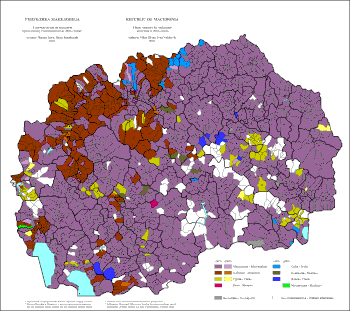Romani people in North Macedonia
According to the last census from 2002, there were 53 879 people counted as Romani in what is now North Macedonia, or 2.66% of the population. Another 3 843 people have been counted as "Egyptians" (0.2%).
 Macedonian Romani children (around 1900) | |
| Total population | |
|---|---|
| 53,879 (2002 census) 80,000 to 260,000 (Unofficial estimations) | |
| Languages | |
| Romani (Balkan Romani) and Macedonian | |
| Religion | |
| Sunni Islam 75%, Christianity 25% [1] |
| Part of a series on |
| Romani people |
|---|
|
Diaspora
|
|
Other sources claim the number to be between 80 000[2] and 260 000[3] Roma in North Macedonia or approximately 4 to 12% of the total population.
The municipality of Šuto Orizari is the only municipality in the world with a Romani majority and the only municipality where Romani is an official language alongside Macedonian. The mayor of the municipality, Kurto Dudush, is an ethnic Roma.
In 2009, the Government of the Republic of North Macedonia took measures to enlarge inclusion of Romani in the education process.[4]
North Macedonia is the region's leader in respecting the rights of the Romani people. It is the first country in the region with a minister of Romani ethnicity and also has many Romani in high government positions. However, there is still a lot to be done concerning the education and integration of the Romani.[5]
History
Origin
The Romani people originate from Northern India,[6][7][8][9][10][11] presumably from the northwestern Indian states Rajasthan[10][11] and Punjab.[10]
The linguistic evidence has indisputably shown that roots of Romani language lie in India: the language has grammatical characteristics of Indian languages and shares with them a big part of the basic lexicon, for example, body parts or daily routines.[12]
More exactly, Romani shares the basic lexicon with Hindi and Punjabi. It shares many phonetic features with Marwari, while its grammar is closest to Bengali.[13]
Genetic findings in 2012 suggest the Romani originated in northwestern India and migrated as a group.[7][8][14] According to a genetic study in 2012, the ancestors of present scheduled tribes and scheduled caste populations of northern India, traditionally referred to collectively as the Ḍoma, are the likely ancestral populations of the modern European Roma.[15]
In February 2016, during the International Roma Conference, the Indian Minister of External Affairs stated that the people of the Roma community were children of India. The conference ended with a recommendation to the Government of India to recognize the Roma community spread across 30 countries as a part of the Indian diaspora.[16]
Language
The Romani in Macedonia speak three different dialects: Arli (the most prominent of the three), Džambaz, and Burgudži.[17]
Gallery
- Romani minority in North Macedonia (census 2002)
- Romani minority in North Macedonia (census 2002)
References
- "Roma muslims". Romafacts.uni-graz.at. Retrieved 15 December 2017.
- "ABCD". Romnews.com. Retrieved 15 December 2017.
- "Archived copy" (PDF). Archived from the original (PDF) on 2016-01-13. Retrieved 2017-09-04.CS1 maint: archived copy as title (link)
- "Изградбата на Коридорот 8 може да почне во 2014 година". Влада на Република Македонија. 2012-03-16.
- "Archived copy". Archived from the original on 2009-07-19. Retrieved 2009-08-04.CS1 maint: archived copy as title (link)
- Hancock 2002, p. xx: ‘While a nine century removal from India has diluted Indian biological connection to the extent that for some Romani groups, it may be hardly representative today, Sarren (1976:72) concluded that we still remain together, genetically, Asian rather than European’
- Mendizabal, Isabel (6 December 2012). "Reconstructing the Population History of European Romani from Genome-wide Data". Current Biology. 22 (24): 2342–2349. doi:10.1016/j.cub.2012.10.039. PMID 23219723.
- Sindya N. Bhanoo (11 December 2012). "Genomic Study Traces Roma to Northern India". The New York Times.
- Current Biology.
- K. Meira Goldberg; Ninotchka Devorah Bennahum; Michelle Heffner Hayes (2015-09-28). Flamenco on the Global Stage: Historical, Critical and Theoretical Perspectives. p. 50. ISBN 9780786494705. Retrieved 2016-05-21.
- Simon Broughton; Mark Ellingham; Richard Trillo (1999). World Music: Africa, Europe and the Middle East. Rough Guides. p. 147. ISBN 9781858286358. Retrieved 2016-05-21.
Roma Rajastan Penjab.
- Šebková, Hana; Žlnayová, Edita (1998), Nástin mluvnice slovenské romštiny (pro pedagogické účely) (PDF), Ústí nad Labem: Pedagogická fakulta Univerzity J. E. Purkyně v Ústí nad Labem, p. 4, ISBN 978-80-7044-205-0, archived from the original (PDF) on 2016-03-04
- Hübschmannová, Milena (1995). "Romaňi čhib – romština: Několik základních informací o romském jazyku". Bulletin Muzea Romské Kultury. Brno: Muzeum romské kultury (4/1995).
Zatímco romská lexika je bližší hindštině, marvárštině, pandžábštině atd., v gramatické sféře nacházíme mnoho shod s východoindickým jazykem, s bengálštinou.
- "5 Intriguing Facts About the Roma". Live Science.
- Rai, N; Chaubey, G; Tamang, R; Pathak, AK; Singh, VK (2012), "The Phylogeography of Y-Chromosome Haplogroup H1a1a-M82 Reveals the Likely Indian Origin of the European Romani Populations", PLoS ONE, 7 (11): e48477, doi:10.1371/journal.pone.0048477, PMC 3509117, PMID 23209554
- "Can Romas be part of Indian diaspora?". khaleejtimes.com. 29 February 2016. Retrieved 4 March 2016.
- Korhonen, Jani; Makartsev, Maxim; Petrusevka, Milica; Spasov, Ljudmil (2016). "Ethnic and linguistic minorities in the border region of Albania, Greece, and Macedonia: An overview of legal and societal status" (PDF). Slavica Helsingiensia. 49: 35.
